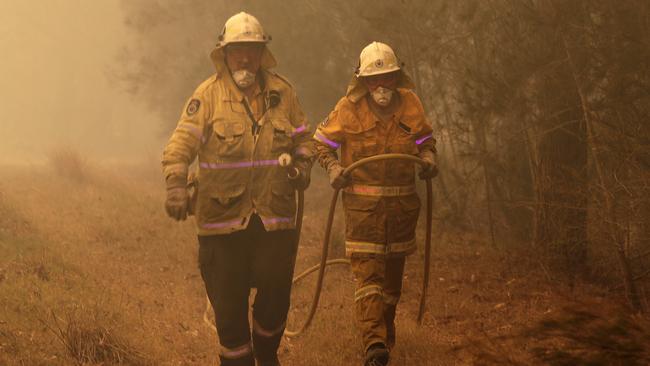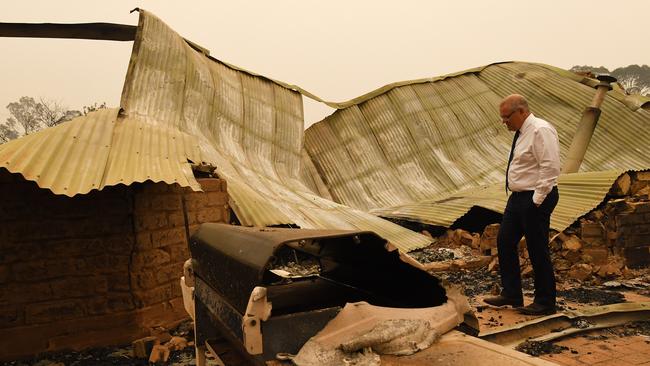Scott Morrison is on a hiding to nothing over bushfires
Australia will never have enough resources to save every home from every bushfire. But if the PM wants to regain control, risk management to the forefront of his actions, writes Peta Credlin.
Scott Morrison is on a hiding to nothing when it comes to bushfires.
Because he’s not theological about climate change, he can never please the green left.
And because state governments are in charge of land management, he can’t order the changes needed to satisfy the pragmatic right.
While these fires are not unprecedented – remember the 1983 Ash Wednesday fires when 75 people died and the 2009 Black Saturday fires that killed 173 people – what’s different is their duration, the mass evacuation of tens of thousands of people from popular holiday spots, and the very contemporary urge to manage everything up to the Prime Minister.
And he didn’t help himself by going on holidays at the wrong time, to the wrong place, and with the wrong media strategy.
RELATED: Thousands of defence personnel deployed across nation for bushfire emergency
These days, every extreme weather event is taken as “proof” that climate is changing.
It doesn’t matter that there have been bigger storms, worse droughts, more destructive floods, and even hotter fires in the past because memories are short and we’re always preoccupied with today’s drama. Because he fully subscribes to the climate cult and because he smartly sought help from the military almost as soon as the fires made it to Victoria, Premier Daniel Andrews has largely escaped criticism – even though he too was on holiday until Monday night and just three years ago, he tried to emasculate the Country Fire Authority and its volunteer firefighter base to please his union mates.

In NSW, Gladys Berejiklian has emerged in front politically too despite the reality that the state government, through the NSW National Parks service, have made the fire situation worse with almost two decades of ever-increasing green tape around hazard reduction burns and fire trail maintenance.
The Premier’s standing is due in large measure to the fact she’s been indefatigable in being ‘present’; daily briefings from fire chiefs, media updates and careful visits to fire-ravaged areas to assess what more can be done.
RELATED: RFS chief clashes with government over fire funding
In stark contrast, her emergency services minister, David Elliott, the one politician who actually has the job of getting us through this calamity, has been on holidays in Europe. Now that he has returned, he should be sacked for deserting his post; he has lost all credibility with fire volunteers, and the community.
But, even though bushfires – avoiding them and fighting them – is the job of state governments, it’s Scott Morrison they’re really after and here’s why.
More and more, we elevate everything to Canberra. More and more we let slack local councils off the hook and pass over underperforming state governments. Constitutionally and under a multitude of laws, the states have clear responsibility for a vast number of matters, indeed using the military in an emergency must be formally requested by a state before Morrison can even send them in.

Partly because of Hawaii, partly because of arrogant comments like ‘I don’t hold a hose’ and a lot due to the fact that the Left want to make this all about climate change, Morrison is under attack from all sides. When he hosts a reception for the national cricket team, he should be helping with the fires. When he visits the fire-devastated township of Cobargo he’s slammed by justifiably angry locals for supposedly not doing enough.
So what should Morrison be doing in this era when the national leader is responsible for everything, even when he is not?
MORE FROM PETA CREDLIN: Is paying volunteer firefighters worth the long-term price?
The first thing I would say is that it’s not easy for the PM to get the balance right between showing he cares by fronting up to disaster zones, and getting in the way.
After twenty years in the fire brigade, Tony Abbott was always reluctant to do the media’s urging and engage in (as he called it), ‘disaster tourism’ because he argued politicians just got in the way of emergency workers, and because local people are often too traumatised to be other-than-angry with anyone not wearing a uniform. But there’s no substitute for being on the ground, and therefore the challenge for the PM is to better manage the timing of visits, and how they’re handled.

A good start would be for his media team to insist that boom mics and cameras respect people’s privacy; less PR stunts and more upfront press conferences are what’s needed.
While state governments fund and run the fire services, and are responsible for national parks, the federal government has two very important ways to make a difference in times like this – the Australian Defence Force, and immediate financial support.
RELATED: Australian stars express bushfire heartbreak
There’ve been a lot of calls to use the military more to fight fires but asking soldiers to fight fires is as unrealistic as asking firemen to fight wars. But where the military can make a real impact is with logistics – with helicopters evacuating people and delivering supplies, amphibious ships performing mass evacuations where roads are impassable, helping to establish disaster refuge centres and using army engineers to reopen roads and bridges, or use earthmoving equipment to create firebreaks.
We quickly deploy these sorts of ADF resources to natural disasters in our region, but appear slow to deploy domestically. This must change and a better cross-government protocol must be established; least of all, the National Security Committee of Cabinet should have met a hell of lot earlier than yesterday to discuss this fire emergency; Christmas period or not.

Financial support to those affected is another area of key Commonwealth responsibility; there’s an immediate cash payment to (literally) put clothes on the back of those who have lost everything and then ongoing financial support for up to 13 weeks.
NSW minister Andrew Constance, who himself was fighting fires last week, had a swipe at the PM saying this money is too slow to arrive, and requires too much paperwork. Constance is right and that’s why Centrelink must have staff on hand in the disaster recovery centres to process payments on the spot – what’s the point of having all this technology if we don’t use it?
RELATED: US, Canadian firefighters will help local efforts in bushfire crisis
Bearing in mind what I said earlier about ‘disaster tourism’, for the next few days and weeks, the PM’s job is to be present for fire emergency briefings and front a press conference because in anxious times, people need reassurance that everything possible is being done, and that someone they elect is on the job. While doing this, his officials and ministers need to be crafting a reconstruction package that can be announced in the next few days, before it’s demanded by angry fire victims.

Inevitably, there will be an inquiry when all of this is over, probably multiple ones; and who does it, and what the terms of reference will be, is critical.
Right now, the hard left are fighting tooth and nail to frame these fires as a climate change event notwithstanding the fact that almost all fires are started by lightning strikes or arson. This is because the extreme environmental lobby has made sound fire management practices almost impossible to implement, states have not resourced bodies appropriately to manage our increasing fuel-load, activists have infiltrated the management of our national parks and weak ministers have let them get away with it, sustainable forestry has been demonised, and farmers have been restricted in managing the fire risk on their own land.
Blaming climate change for bushfires is an easy out for green-driven state governments that have failed to manage fuel loads over the past 20 to 30 years.
No-one seriously believes going 100 per cent renewable tomorrow would end bushfires in this country but that’s the logical conclusion of this illogical argument.
In a country as vast as ours, we will never have enough fire-trucks, water bombers or volunteers to save every home. But what we can do – what we must do – is make the job easier by managing risk. We used to do it, Indigenous Australians have always done it and that’s got to be where the PM needs to lead this debate.

